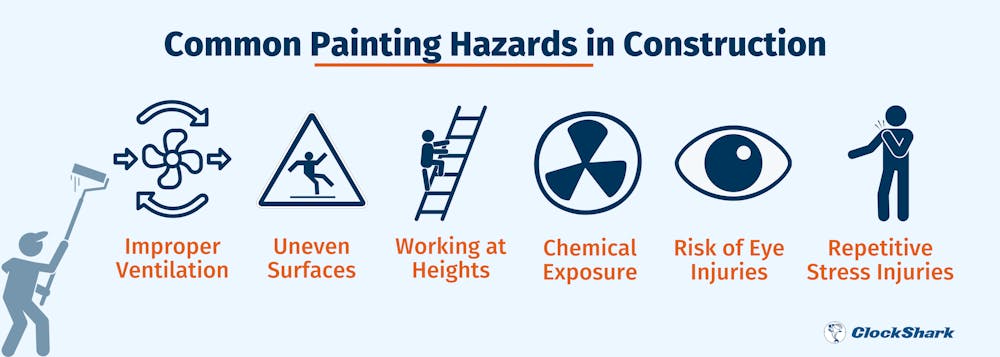Painting contractors and crew members who perform paint tasks on a jobsite face certain unique safety issues that others may not. While these risks are different from other construction jobs, they are not any less hazardous. That’s why it’s important to understand the importance of painting safety so you can keep your crews safe on the job.
Understanding the Risks Associated With Painting
There are countless risks associated with construction painting, with some being less obvious than others. It’s important to point out that most professional paint contractors are aware of these hazards when properly trained. However, when you have general laborers or other workers performing painting tasks on the jobsite, they may not be as well-versed or educated in the hazards that exist around painting projects.
Some of these hazards may be immediately recognizable. However, others may take years to show up. That’s why it’s important to be familiar with the risks associated with painting, and to take precautions to avoid injury or worse, on the jobsite.
Most Common Painting Hazards in Construction
While the majority of painting contractors won’t be lifting heavy equipment for the most part, their responsibilities and work do pose other health risks and risks of injury. While OSHA does have general safety guidelines and requirements for painting in construction, different states may also have requirements that are beyond OSHA’s, so it’s important to determine if the state you’re working in has its own safety agency, and familiarize yourself with those requirements, if applicable. You can find out, here.
Here are just a few of the most common injuries for painting contractors or those performing painting duties in construction.

1. Improper Ventilation
Painting contractors work with a lot of different chemicals that require proper ventilation. In some cases, simple solutions like opened windows and doors are not possible (perhaps in a basement or enclosed space), so it’s necessary to find alternative means to protect workers who are painting.
2. Uneven Surfaces
Whether it be adjoining rooms, unfinished floors, or other obstructions, uneven surfaces pose hazards to painters.
3. Working at Heights
Painters frequently must use ladders to reach higher spaces, including ceilings and hard-to-reach spaces. Sometimes, this involves working with scaffolding which poses additional safety risks.
4. Chemical Exposure
Painters are exposed to countless chemicals in different ways. Aside from inhaling these chemicals, dermal (skin) contact is another way exposure can happen, which can result in burns and rashes. Research has found painters stand at a much higher risk than normal, of developing different types of cancer, including mesothelioma, bladder, and lung cancer.
5. Risk of Eye Injuries
Naturally, chemicals can either splash or cause eye irritation, just from exposure. Additionally, often painters must prepare surfaces to paint, which leads to flakes and dust particles in the air that can get into the eyes.
6. Repetitive Stress Injuries
Painters use a lot of the same motions when performing their duties, which can lead to Repetitive Strain Injury (RSI). RSI is caused by repetitive motions and frequent use of the same muscles, which leads to a gradual increase of damage to muscles, tendons, and nerves of the over-used areas.
Tips for Increasing Painting Safety and Reducing Risks
Painting contractors are faced with unique safety hazards, but there are multiple ways to reduce the risk of these issues on your jobsites and protect your painting professionals. Properly preparing the work area involves multiple steps, but they’re worth it to keep workers safe.
Conduct Safety Assessments
While the risks associated with painting are generally the same, each work area is different and each job will come with its own set of risks and hazards. Do a walkthrough of the area and take note of any dangerous factors present. From there, you can proactively assign corrective measures and/or provide additional protection where needed.
Use Personal Protective Equipment (PPE)
OSHA requires the use of PPE on construction sites for workers, but the type of PPE for painters will vary, depending on the job. For example, when working on an exterior paint job, ventilation may not be as much of a risk as an interior paint job. However, there are still respiratory risks, regardless of ventilation. To be safe, provide painters with the right PPE which can include:
- Gloves
- Respiratory masks (disposable, reusable, or dust masks)
- Eye protection
- Coveralls/Shoe covers
- Hard hat
- Fall arrest system (if working from heights)
- Fire extinguisher
Keep Good Ventilation
Proper ventilation is required by OSHA, to ensure the safety of air quality when working. In the case of areas without air ducts or closed spaces, employees must be “protected by respirators.” Additionally, closed spaces should remain open until the area has reached a safe level of clean air.
Ensure Your Crew Has Painting Safety Training
Most professional painters are aware of the occupational hazards they face. However, your non-painting workers may not be familiar with safety precautions and, thus, create dangerous situations or inadvertently cause health or safety risks. Be sure they’re regularly reminded of the health and safety rules around painting and chemicals.
Use of Appropriate Equipment and Products
As with any job, it’s important to use the right tools and products to do the best (and safest) job. Cutting corners to save time or money can end up costing more, so it’s more effective to follow OSHA painting regulations, to ensure everyone stays safe and avoid OSHA safety violations.
Understand Painting Safety on the Jobsite
The importance of job safety is crucial for all construction sites, and painting poses unique threats to health and safety. Be sure your crews are kept safe from these hazards by ensuring everyone has the right tools and equipment, as well as training to be aware of - and avoid - these hazards.









